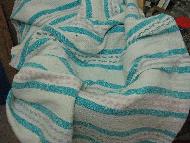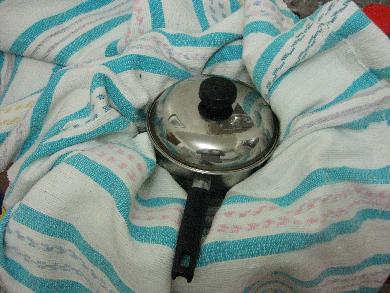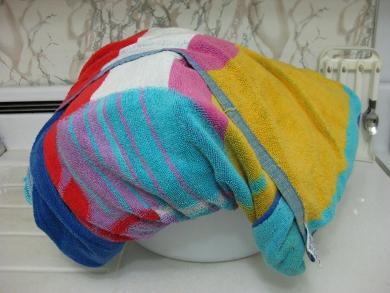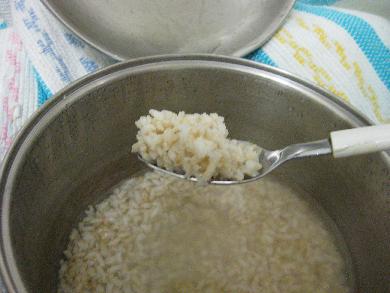What is heat-retention cooking?
|
Heat-retention cooking, also known as hay box cooking, is a way of cooking food using stored heat instead of using the stove. Often a recipe asks you to cover something and leave it simmering with the stove turned on low. The reason the stove is left on is because while the pot is sitting there it's losing heat to the surrounding air. The stove's job is to make up for that lost heat. So why not just prevent the heat loss to the surrounding air in the first place and leave the stove off! That's what heat-retention cooking does. It retains the heat by having the pot be covered in insulation. No need for the stove anymore. |
|
An example of heat-retention cooking using long grain brown rice
The normal way to cook long grain brown rice (for one person) is:
- put 1/4 cup rice in a pot,
- add 1 2/3 cup water,
- bring rice and water to a boil,
- cover, turn heat to low and leave for 45 minutes.
The heat-retention way of cooking it is (the differences are highlighted below):
- put 1/4 cup rice in a pot,
- add 1 2/3 cup water,
- bring rice and water to a boil,
- cover, turn heat to low and leave for 10 minutes (see section on preventing bacterial growth below),
- remove pot from stove, turn stove off and leave it off. Put the pot in a thickly insulated container for 40 minutes.
At least that's the way I do it. You can experiment with the times to find what works for you.
A simple way to make a thickly insulated container for step 5 is shown in the following photos. To start with get a large bowl: plastic, metal, straw, cardboard box, ... it doesn't matter. Then make a thick insulated bottom in the bowl by laying in some towels and/or blankets. Make sure the towels and blankets have lots of remainder hanging over the edge because you'll need that to wrap around the top of the pot. You want it add up to something fairly thick so be generous. The more you put, the slower the pot will lose heat and the less extra cooking time you'll have to add over the normal cooking time. When you put it in, make sure you follow the shape of the bowl because you're really just making a bowl within a bowl.
|
Then, to finish step 5, put the heated pot in the insulated container as in the photo below. Then wrap the towels and/or blankets up over the top of the pot making sure you have as thick a layer on top of the pot as you do below the pot.
You can stop there or you can do what I do, put it in the oven. But don't turn the oven on! An oven is fairly well insulated. So if your room is drafty or cold, the oven is a good place to put it. Close the oven door and wait a suitable amount of time.
|
|
The photo below shows the result. After only 10 minutes simmering on the stove and 40 minutes in the insulated container, the rice is nice and fluffy.
|
Preventing bacterial growth
There is a danger of bacterial growth if cooking food for long periods of time below 60C (140F). One approach to preventing this danger is to cook the food above 60C for 10 minutes before putting it in the insulated container. Another approach is to reheat the food to boiling (which is 100C (212F)) just before eating it.
Other heat-retention cooking notes
The large plastic bowl that I used above is optional. It just helps make a stable container. If you didn't use the bowl to start with then you'd just have a pot wrapped in blankets and there's danger that if you move it around you might put the pot sideways and spill the contents into the blankets!
After you're done you can tell how effective your insulating layers are. If only the innermost layer (towel, blanket) is warm but none of the others are then you lost heat only to that innermost layer. That's good. If all the layers are warm then you're losing a lot of heat and even some to the surrounding air. Maybe try thicker materials or more layers. You want materials that have a lot of air trapped inside them. So thick towels are good but bed sheets are not so good.
You'll notice that after you are done and you remove the pot from the blankets that the innermost blanket is nice and warm. Wrap it around you while you enjoy your meal!
You can also put the pot under the blankets in your bed. When it is done, eat your food under the nice warm blankets!









